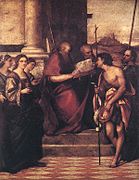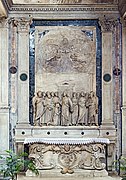
Giovanni Bellini was an Italian Renaissance painter, probably the best known of the Bellini family of Venetian painters. He was raised in the household of Jacopo Bellini, formerly thought to have been his father, but now that familial generational relationship is questioned. An older brother, Gentile Bellini was more highly regarded than Giovanni during his lifetime, but the reverse is true today. His brother-in-law was Andrea Mantegna.

The Basilica di Santa Maria Gloriosa dei Frari, commonly abbreviated to the Frari, is a church located in the Campo dei Frari at the heart of the San Polo district of Venice, Italy. It is the largest church in the city and it has the status of a minor basilica. The church is dedicated to the Assumption of Mary.

The Basilica dei Santi Giovanni e Paolo, known in Venetian as San Zanipolo, is a church in the Castello sestiere of Venice, Italy.

BartolomeoMontagna was an Italian Renaissance painter who mainly worked in Vicenza. He also produced works in Venice, Verona, and Padua. He is most famous for his many Madonnas and his works are known for their soft figures and depiction of eccentric marble architecture. He is considered to be heavily influenced by Giovanni Bellini, in whose workshop he might have worked around 1470. Benedetto Montagna, a productive engraver, was his son and pupil and active until about 1540. He was mentioned in Vasari's Lives as a student of Andrea Mantegna but this is widely contested by art historians.

Sebastiano del Piombo was an Italian painter of the High Renaissance and early Mannerist periods famous as the only major artist of the period to combine the colouring of the Venetian school in which he was trained with the monumental forms of the Roman school. He belongs both to the painting school of his native city, Venice, where he made significant contributions before he left for Rome in 1511, and that of Rome, where he stayed for the rest of his life, and whose style he thoroughly adopted.

San Bartolomeo is a church in Venice, Italy. It is near the Rialto Bridge in the sestiere (district) of San Marco.

The Tempio della Beata Vergine della Ghiara, also known as Basilica della Madonna della Ghiara, is a church in Reggio Emilia, northern Italy. The building is the property of the comune (municipality) of the city.

Sant'Onofrio al Gianicolo is a titular church in Trastevere, Rome. It is the official church of the papal order of knighthood Order of the Holy Sepulchre. A side chapel is dedicated to the Order and a former grand master, Nicola Canali is entombed there. It is located on the Janiculum. Since 1946, the church has been under the care of the American congregation of the Franciscan Friars of the Atonement.

San Francesco della Vigna is a Roman Catholic church in the Sestiere of Castello in Venice, northern Italy.

The Madonna dell'Orto is a church in Venice, Italy, in the sestiere of Cannaregio.
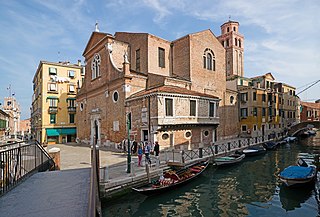
San Martino is a Renaissance Roman Catholic church in the sestiere of Castello of Venice, northern Italy.
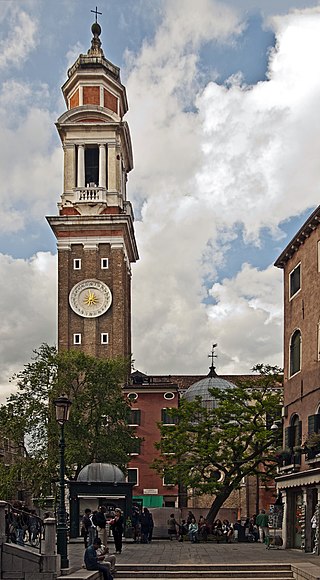
The Chiesa dei Santi Apostoli di Cristo, commonly called San Apostoli, is a 7th-century Roman Catholic church located in the Cannaregio sestiere of the Italian city of Venice. It is one of the oldest churches in the city and has undergone numerous changes since its foundation. The present building is the result of a major reconstruction project which was undertaken in 1575. The church is notable particularly for the Cornaro Chapel, an important example of Early Renaissance architecture, added by Mauro Codussi during the 1490s. The chapel is the burial place of several members of the powerful Cornaro family, including Catherine Cornaro, Queen of Cyprus and Armenia. The church houses several works of art including pieces by Giambattista Tiepolo and Paolo Veronese.
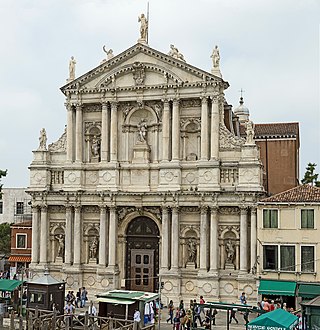
Santa Maria di Nazareth is a Roman Catholic Carmelite church in Venice, northern Italy. It is also called Church of the Scalzi being the seat in the city of the Discalced Carmelites religious order. Located in the sestiere of Cannaregio, near Venezia Santa Lucia railway station, it was built in the mid-17th century to the designs of Baldassarre Longhena and completed in the last decades of that century.

The San Giobbe Altarpiece is a c. 1487 oil painting by the Italian Renaissance master Giovanni Bellini. Inspired by a plague outbreak in 1485, this sacra conversazione painting is unique in that it was designed in situ with the surrounding architecture of the church, and was one of the largest sacra conversazione paintings at the time. Although it was originally located in the Church of San Giobbe, Venice, it is now housed in the Gallerie dell'Accademia in Venice after having been stolen by Napoleon Bonaparte.
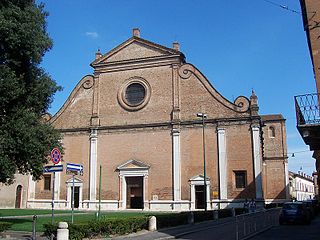
San Francesco is a late-Renaissance, Roman Catholic minor basilica church located on via Terranuova in Ferrara, Emilia-Romagna, Italy.

The Galleria Giorgio Franchetti alla Ca' d'Oro is an art museum located in the Ca' d'Oro on the Grand Canal in Venice, Italy.

Santa Maria delle Grazie is a Baroque-style, Roman Catholic basilica church located in the town of Este in the province of Padova, region of Veneto, Italy. Within the shrine is the image of the Blessed Virgin Mary of Graces, transferred from the ransack of Constantinople and ultimately crowned by Pope Pius VII in 10 December 1822.

The Pesaro Altarpiece is an oil on panel painting by Giovanni Bellini, dated to some time between 1471 and 1483. It is considered one of Bellini's first mature works, though there are doubts on its dating and on who commissioned it. The work's technique is not only an early use of oils but also of blue smalt, a by-product of the glass industry. It had already been used in the Low Countries in Bouts' 1455 The Entombment, but this marked smalt's first use in Italian art, twenty years before Leonardo da Vinci used it in Ludovico il Moro's apartments in Milan in 1492. Bellini also uses the more traditional lapis lazuli and azurite for other blues in the work.

The Barbarigo Altarpiece or Enthroned Madonna and Child with Angel Musicians and Saint Mark, Saint Augustine and Doge Agostino Barbarigo is a 1488 oil painting on panel by Giovanni Bellini, now in the church of San Pietro Martire in Murano.

The St John Chrysostom Altarpiece is a 1510–1511 oil on canvas painting by Sebastiano del Piombo, that is kept in San Giovanni Grisostomo, Venice. It belongs to the sacra conversazione genre.




